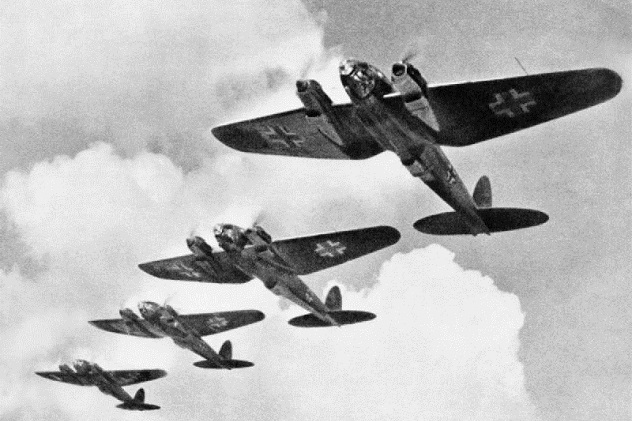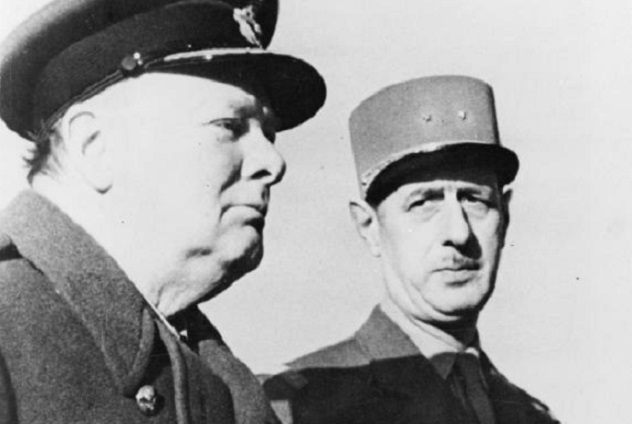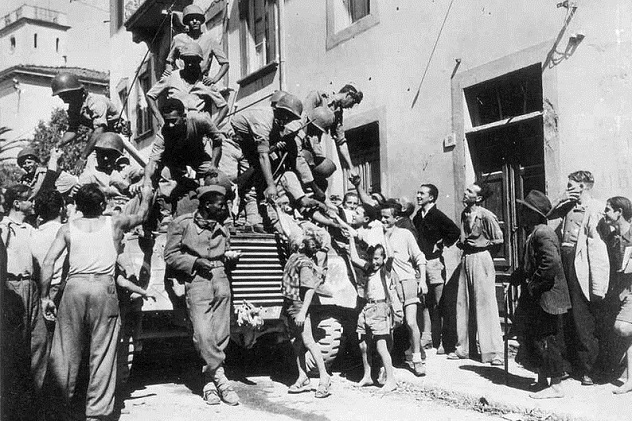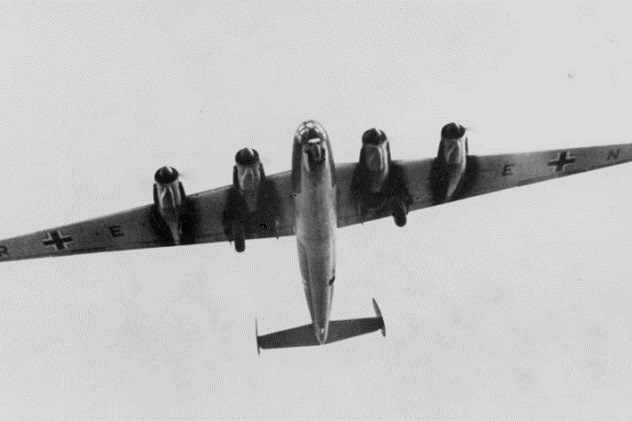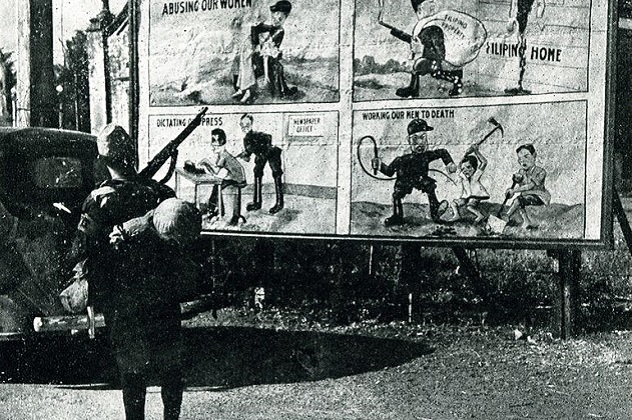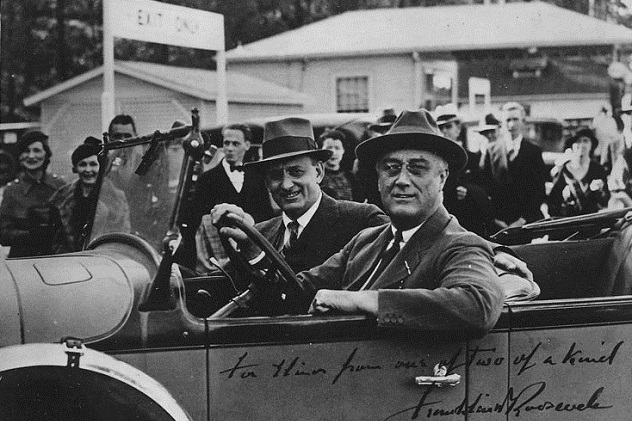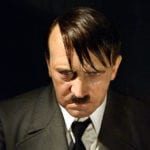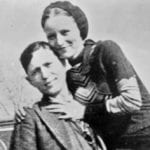10The Mechelen Incident
German military planners were convinced that attacking France and Britain head-on was near suicidal. Franz Halder, the chief of staff of the Army High Command (OKH), concocted an unimaginative advance eerily similar to the Schlieffen Plan of 1914 which ground to a halt. Halder’s intention was to make Hitler see the futility and senselessness of such an attack, which would commit half a million German troops to attacking in January 1940, gaining a static frontline, and waiting two years until another offensive could take place. General Erich von Manstein, however, had a different idea in mind. He wanted to use elite panzer units to strike from the south, breaking through the Sedan and cutting off the Allies in the north. Manstein drew up multiple variations of his plan, all of which were rejected. Rivals even gave him a hollow posting just so they could be rid of him. On January 10, 1940, two German officers carrying copies of Halder’s plans got lost while flying over Mechelen, Belgium. They were forced to land and unable to burn the documents before they were captured. Upon learning of the “Mechelen Incident,” Hitler was livid, though no immediate changes were made to the invasion plans. Fear and worry began to creep into the minds of Hitler and his generals, at which point the Fuhrer himself suggested an attack through the Sedan. When he learned that one of his generals had already made a detailed stratagem, he was ecstatic. Recovering the abandoned German military plans doomed the Allies. They began massing even more troops on the Belgian frontier, oblivious to Germany’s intentions. The Fall Gelb (“Case Yellow”) which led to the Fall of France and The Low Countries owes its success to a crafty general and two Germans lost in Belgium.
9The Franco-British Union
With French morale crumbling and Britain in danger of facing the German onslaught alone, politicians needed to come up with a plan to keep the alliance intact. Arthur Salter and Jean Monnet , members of the Anglo-French Coordination Committee, proposed the Franco-British Union. French citizens would be granted British citizenship and vice versa, and the parliaments of both nations would be united. Every man, machine, and resource in their domain would be used to pursue a single directive. The plan was audacious, but General Charles de Gaulle loved it, while Winston Churchill considered it a necessary gamble. French Prime Minister Paul Reynaud became convinced after events took an unexpected turn, but several French politicians scoffed at the idea. Marshal Philippe Petain himself considered the union a “marriage to a corpse.” The proposal was put to a vote and defeated 14 to 10. Churchill responded, “Rarely has so generous a proposal encountered so hostile a reception.” Indeed, the Franco-British Union enamored the populace so much that stamps were designed in anticipation of such a momentous event. Petain replaced Reynaud and immediately called for an armistice. Germany would occupy northern and western France, and Petain would head the administration from Vichy. De Gaulle would lead the men of Free France against brother and kin. Had Petain and the defeatists not stepped in, France might have continued the fight. It would have been a huge step toward today’s European Union, though it would also have untold consequences for the colonial empires of both nations. Perhaps the most immediate change in history was that France would have avoided being the butt of surrender jokes for decades to come.
8Battleground: Ireland
Representatives of the British and Irish governments held a secret meeting to discuss potential cooperation against Germany on May 23, 1940. A month later, a British minister offered post-war unity in exchange for the use of Ireland’s military facilities and its active participation in the war. These were the beginning stages of “Plan W,” a series of proposed joint military operations between Ireland and the United Kingdom. The Prime Minister of Northern Ireland preferred a more brusque approach—a British invasion. Lord Craigavon requested that Churchill send Highland troops to overthrow the Irish government in Dublin, which would have given Britain the bases it needed. Even Field Marshal Montgomery was told to “prepare plans for the seizure of Cork and Queenstown.” Trouble brewed on the horizon as well, as Nazi spies and their IRA contacts devised “Plan Kathleen.” It called for 50,000 German soldiers to invade Northern Ireland with the assistance of 5,000 members of the IRA and relied on sabotage, propaganda, and inciting rebellious and dissident elements. The plan never materialized, as German agents and their IRA contacts were soon captured. The Army High Command had a plan that relied less on covert actions—the outright takeover of Eire called “Operation Green”—but mounting losses in aerial battles rendered it unfeasible. Nazi enthusiasm for such plans was revived once more in 1941 by General Kurt Student, an expert on commando and paratrooper tactics. Student proposed an airborne assault requiring over 30,000 troops that Hitler seriously considered before the idea was aborted.
7The US Invasion Of Brazil
After the stunning German victory over France, concern grew that Brazil might side with the Axis. Its leader, Getulio Vargas, had attained power through nefarious means. The region’s population was also fiercely nationalistic, and there were pro-Fascist elements in the military as well. Since Brazil’s northeastern “hump” was the shortest route to West Africa, military planners pointed out that Germany would be closer to the Americas than ever before. The Abwehr’s vast network of spies within the continent also became a problem. Fear in Washington intensified when Brazil initially refused access to its bases. The operation, known as “Plan Rubber,” called for 64,000 US troops to invade Brazil, primarily targeting Natal, Recife, and Belem. It was believed so strongly that the invasion was inevitable that rigorous preparations were made, including naval and amphibious exercises, but ultimately, cooler heads prevailed. On January 29, 1942, during the Pan-American Conference held in Rio de Janeiro, virtually every country in the Americas severed ties with the Axis powers. In August, Germany retaliated. The U-507, a German submarine, sank five ships off the coast of Brazil, convincing the country to enter the conflict on the side of the Allies. One rash move like “Plan Rubber” could have jeopardized everything.
6Beating Germany To Ploesti’s Oil Fields
In 1940, Romanian lands were given to Hungary and Bulgaria. Similarly, the Soviets demanded Bessarabia and Bukovina, and the Romanians acceded. Red Army forces quickly fortified the new borders from June 28 to July 4, 1940. This move put the Red Army within 160 kilometers (100 mi) of Ploesti’s oil fields. With Germany distracted at the Western front, the Soviets seemed poised to launch a strike at any time before Romania formally joined the Axis in November. Some claim that even if Stalin had designs on Romania, he wasn’t ready to face Germany. British ambassadors urged Stalin to meet the German threat to no avail. Had Stalin acted, it would have spelled the end for the Nazis. During Hitler’s meeting with Finland’s Marshal Mannerheim, he confided the truth to him about the Reich’s situation. He told Mannerheim that if the Soviets attacked the oil fields immediately, Germany would have been lost—60 Russian divisions would have been enough to do the job. By 1941, Germany would have been a mere sitting duck. While that would have meant no Barbarossa, some military historians claim it could have also meant a terrible Soviet onslaught directed toward the rest of Europe.
5Poland And Turkey In The Axis
To avert war, Danzig was to be reunited with the Reich. An autobahn was to be built connecting greater Germany and East Prussia, while goodwill and cooperation would link Poland with the Nazis for at least a quarter of a century. The Western powers gravely feared that Poland would side with the Germans. In 1938, after Czechoslovakia was dismantled, the Poles also reaped the benefits by demanding territory from the Czechs. German ministers promised aid against the Soviet Union and reminded the Poles of their aspirations to control the Ukraine. Ultimately, the question is whether Poland, which suffered a lot throughout the conflict, would have been left in a worse state if it had sided with Germany. In Turkey, similar plans were made to convince the Turkish government to side with the Axis. There were talks of forming a Pan-Turanian Republic from the hinterlands of the Soviet Union as well as inciting Muslim POWs to mutiny and rebel against their Russian superiors. Pro-Axis sentiments actually spiked following Operation Barbarossa in 1941, but Turkey was never to be fully committed to the war effort unless the defeat of the Soviet Union was imminent.
4The Axis Invasion Of America
Had everything gone as planned for the Germans, we would have seen the true capabilities of the Messerschmitt-264, which was designed to have a range of 15,000 kilometers (9,320 mi). Dubbed the “Amerika Bomber,” it would have been able to deliver its payload on the eastern United States. During a broadcast following an assassination attempt on Hitler on July 20, 1944, the Me-264 was reportedly made ready to fly the Fuhrer to Japan in the event that his generals succeeded in overthrowing him. German scientists also espoused the use of chemical weapons on the US. One had advised Hitler to “attack America simultaneously with various human and animal pathogens, as well as plant pests.” The Japanese were also keen on such an undertaking, devising a grandiose operation to attack the Panama Canal using a submarine that was also an underwater aircraft carrier. The hulking I-400 class was the largest designed at the time and would remain so for several years. It was scheduled to attack the canal on August 25, 1945, but the plan was obviously canceled due to Japan’s surrender. Ultimately, like most “wonder weapons,” the Axis’s efforts were too little, too late to change the war. The I-400 that was to carry out the attack sunk off the coast of Hawaii. Its wreck wasn’t found until August 1, 2013.
3The Ricin Bomb
Ricin is a poisonous agent found in castor beans. Once it gets in the bloodstream, it infects the body’s cells, preventing them from making protein. Ricin can cause severe vomiting, respiratory ailments, seizures, and organ failure leading to death. It’s odorless, tasteless, and nearly invisible. During the war, various nations studied the possible use of the agent. The most significant experiment was conducted by Allied scientists at Edgewood Arsenal. Around 1,700 kilograms (3,700 lb) of the poison known as “Agent W” were produced, and cluster bombs dubbed “W-bombs” were field-tested. One W-bomb would be enough to kill half the population of an area measuring 90 square meters (300 ft2), and there is evidence that the Allies considered the use of ricin bombs against Japan. Had ricin been deployed as a weapon during the war, how would it have affected Japanese determination to defend their homeland? Similarly, how would the world fare years later, when the threat of a fiery mushroom cloud was replaced by the threat of an invisible one?
2War Plan Orange And A Preemptive Strike
“War Plan Orange,” the United States doctrine in the event of war with Japan, called for key areas in the Philippines to be well stocked and defended to the last man. It had been in place for years and rigorously studied, and preparations had been made for all contingencies. According to military experts and historians, there were at least eight hours of delay between the moment Pearl Harbor was attacked to the time when Japanese planes swooped down on American bases in the Philippines. During that time, General Douglas MacArthur had fallen into a state of shock, unable to make a sound decision. The commander of his air forces, General Lewis Brereton, proposed a daring plan: preemptively striking Taiwan, where Japanese planes were based. MacArthur waited several hours to give the order, however, giving the same Japanese aircraft from Taiwan plenty of time to catch the American planes like sitting ducks. The Japanese later bombed the dockyards, and air and naval power were instantly lost due to indecision. MacArthur would follow up with more mistakes. Some areas of the Philippines were not fully stocked with medical supplies, food rations, or water, nor were defenses completely prepared. MacArthur disregarded this important facet of War Plan Orange, erroneously believing that Japan would attack in mid-1942. Thwarting the Japanese landings to the north was an impossible task, as MacArthur sent ill-trained troops to meet them. Meanwhile, his best troops were sent south on guard duty instead. Many brave Americans and Filipinos were subjected to cruelty at the hands of the Japanese in the years to come due to the incapability of one man to carry out a definitive plan that had been in place for years and his rejection of another brought up by a daring soldier in the heat of battle.
1The Morgenthau Plan
A plan drafted by US Secretary of the Treasury Henry Morgenthau in 1944 called for the complete and total disarmament and dismantling of Germany, not just by carving it up into smaller zones of occupation and autonomous areas but reducing it to a “primarily agricultural and pastoral state.” This outlandish and extremist view was wholly supported by President Franklin D. Roosevelt, who abhorred the idea of a “lenient punishment” for the defeated nation. FDR believed that while Germans should not starve to death, it was enough that they be fed nothing but soup three times a day. Everyone else in the Allied camp was completely opposed to the plan, including France and Britain. Winston Churchill berated Morgenthau in person and could only be swayed to change his mind after a promise of $6.5 billion in aid for Britain. Secretary of War Harry Stimson and Secretary of State Cordell Hull remained outraged, though, and once the American media found out about it, all hell broke loose. It was used to full effect by Nazi Minister of Propaganda Joseph Goebbels to rally the populace to fight in utter desperation. Roosevelt had to deny his involvement as election day loomed closer, but he still privately encouraged the Treasury Secretary’s schemes. As the war drew to a close, parts of the Morgenthau Plan were implemented, though somewhat watered down. Aside from the public outcry, historians pointed out that one of the main reasons why the proposal never materialized to its fullest extent was because its greatest supporter, FDR, tragically died in 1945.
+Operation Goldeneye
The Jamaican residence of Ian Fleming, author of the James Bond novels, was known perhaps unsurprisingly as “Goldeneye.” The origin of the name is disputed, but some cite an obscure plan concocted by the man himself during World War II as an inspiration. “Operation Goldeneye” was devised by Fleming as part of the Naval Intelligence Department. In the event that Spain aligned with the Axis powers, Britain was to send spies and saboteurs to the Iberian Peninsula. The operation was eventually scrapped as the war dragged on and Spain remained neutral, much to the chagrin of Germany and Italy. What might have happened in these hypothetical scenarios had everything gone according to plan? What do you think? Talk to Jo via email.
